
Visionary - V. Shantaram
| swarapriya |
 Jan 6 2019, 09:23 PM Jan 6 2019, 09:23 PM
Post
#1
|
|
Dedicated Member  Group: Angels Posts: 15469 Joined: 8-January 08 Member No.: 36307 |
Visionary - V. Shantaram
Few months back I ran across an article about late V. Shantaram. The article traced some of his cinematic accomplishments that I was not aware of before. I knew his films mostly since 50’s, his works like “Jhanak Jhanak Payal Baaje (1955)”, “Do Ankhen Barah Haath (1957)”, “Navrang (1959)” and others. I admired him immensely because of the art and craft of these movies. However, after reading the article I came to understand how little I knew about him. Most of his brilliant work was done in 1930’s and 1940’s through bilingual movies he made in Hindi and Marathi. I have not seen anyone of them before. I decided to dig deeper and share with our Forum members what I was able to unearth about this visionary legend and genius (who was a producer, director, actor, editor, and writer) through this thread. Let us briefly start talking about how this all started… Shantaram did not have much of schooling. In early teens he took up odd jobs like railroad repairs and maintenance work. To supplement his income he took up a job at a local cinema house. For the cinema house he did any work that came by like painting signs, ushering people into the theater, handling movie projection etc. When Dadasaheb Phalke came up with India’s first silent film he was thrilled and developed great admiration and respect for him. While working there at the cinema house he also started watching English films. Shantaram briefly worked for a photographer to learn skills on handling the camera. But he was yearning for more. His second cousin from his mother’s side was working for a company called Maharashtra Film Company that was owned and operated by the great Baburao Painter. The cousin took Shantaram to Painter who hired him to work on anything he can find. Painter was busy making silent movies. Shantaram worked tirelessly and learned everything about making movies. Eventually he get a break as an actor in one of Painter’s films. Later on he also directed a film for Painter. Shantaram’s work can be described through the stints and associations he had with various film companies. These can be described through the following four phases: • Phase 1: Maharashtra Film Company (16 films, all silent) (See the attachment below) • Phase 2: Prabhat Film Company (32 films; 6 silent and rest talkies) (See the attachment below) • Phase 3: Rajkamal Kala Mandir (31 films) (See the attachment below) • Phase 4: V. Shantaram Productions (13 films) (See the attachment below) I am attaching below few photographs of Shantaram. One of them shows several images of him at work. The other one shows some of the awards and recognitions he received. Following are some of the milestones in Shantaram’s film carrier: • “Surekha Haran (1921)” – first silent film as an actor • “Netaji Palkar (1927)” – first silent film as director; co-director was Keshavrao Dhaiber • “Gopal Krishna (1929)” – first silent film under Prabhat; first film with allusions of pre-independence movement; directed by Shantaram • “Rani Saheba (1930)” – first children movie; directed by Shantaram • “Udaykal (1930)” – first movie to politicize (fight against the British rule) Shivaji’s expeditions; directed by Shantaram • “Chandrasena (1931)” – first movie to use a trolley to shoot certain scenes; directed by Shantaram & Keshavrao Dhaiber • “Zulum (1931)” – last silent movie under Prabhat; directed by Keshavrao Dhaiber; Shantaram was one of the producers • “Ayodhyecha Raja (1932)” – first talkie under Prabhat; first Marathi talkie; first bilingual talkie; oldest available talkie in India; directed by Shantaram • “Maya Machhindra (1932)” – first film to use optical superimposition; first film to release its songs on a gramophone record; directed by Shantaram • “Sairandhri (1933)” – first color film made in India; first to have songs pressed on records in Germany from the original motion picture soundtrack; directed by Shantaram • “Amrit Manthan (1934)” – first film to raise voice against animal as well as human sacrifices; first film to celebrate a silver jubilee; first film to use a telephoto lens to show close-ups; directed by Shantaram • “Seetha Kalyanam (1934)” – first and only Tamil film made by Prabhat; directed by Baburao Pendharkar; Shantaram was one of the producers • “Dharmatma (1935)” – first film to explore the issue of untouchability; only devotional film directed by Shantaram • “Jambu Kaka (1935)” – first cartoon film made in India; shown in theaters before Prabhat’s regular features; directed by Shantaram • “Amar Jyoti (1936)” – first film to raise the issue of women’s emancipation; first film to use back projection; first Prabhat film to use a playback singer; first Indian film to be screened at the Venice Film Festival; directed by Shantaram • “Sant Tukaram (1936)” – first film to raise the issue of caste system; first film to run over a year; co- directed by Vishnupant Damle & Sheikh Fateh; Shantaram was one of the producers • “Duniya Na Mane (1937)” – first film to explore the issue of a young woman married to a much older man; directed by Shantaram • “Wahan (1937)” – first film to raise the issue of slavery; directed by Narayan Kale; Shantaram was one of the producers • “Aadmi (1939)” – first film to raise the issue of prostitute rehabilitation; directed by Shantaram • “Sant Dnyaneshwar (1940)” – first film to raise the issue of religious bigotry; first to be screened in USA; first Marathi film broadcast on Doordarshan; co-directed by Vishnupant Damle & Sheikh Fateh; Shantaram was one of the producers • “Padosi (1941)” – first film to showcase the communal problems between Hindus & Muslims; directed by Shantaram • “Shakuntala (1943)” – first film under Rajkamal Kalamandir banner; film deals with women empowerment; first film to be shown abroad in Canada; directed by Shantaram • “Dr. Kotnis ki Amar Kahani (1946)” – first film that explored Indo-Chinese relationship; directed by Shantaram • “Dahej (1950)” – film on the consequences suffered due to the unjust dowry system; directed by Shantaram • “Teen Batti Char Raasta (1953)” – first film about national integration; first film to explore complexities of dark versus fair skin; directed by Shantaram • “Subah ka Tara (1954)” – film deals with perils and subsequent consequences of a man pursuing to marry a widow; directed by Shantaram • “Jhanak Jhanak Payal Baaje (1955)” – first film that dazzlingly displays the artistic richness of Indian classical dances; directed by Shantaram • “Do Ankhen Barah Haath (1957)” – first film to explore jail reforms; won many national and international honors; directed by Shantaram • “Navrang (1959)” – another feast of dances and songs; introduced Mahendra Kapoor as a playback singer; directed by Shantaram • “Geet Gaaya Pattharon Ne (1964)” – introduced Rajshri and Jeetendra as the leading pair in the film; directed by Shantaram • “Ladki Sahyadri Ki (1966)” – first film for which Pandit Jasraj sang a song; directed by Shantaram • “Jal Bin Machhli Nritya Bin Bijli (1971)” – first film for which all songs were recorded in stereophonic sound; directed by Shantaram • “Pinjra (1972)” – first film to introduce the stage actor Shree Ram Lagoo to the big screen; directed by Shantaram It will be a while before we get into talkies, but starting in the next post I will have few details of the first silent film Shantaram acted, “Surekha Haran”… This post has been edited by swarapriya: Jan 6 2019, 09:37 PM Attached image(s)   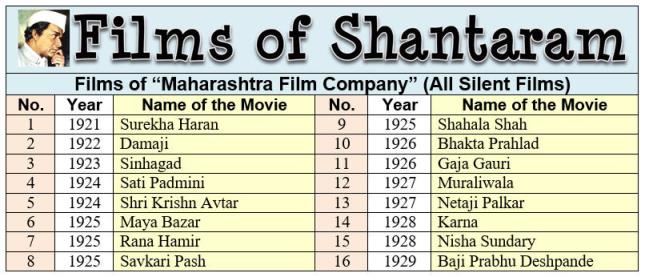 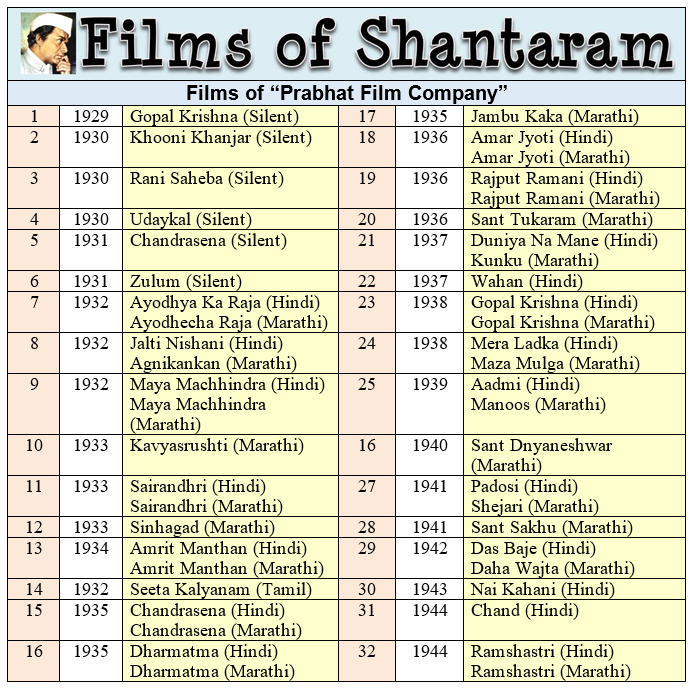 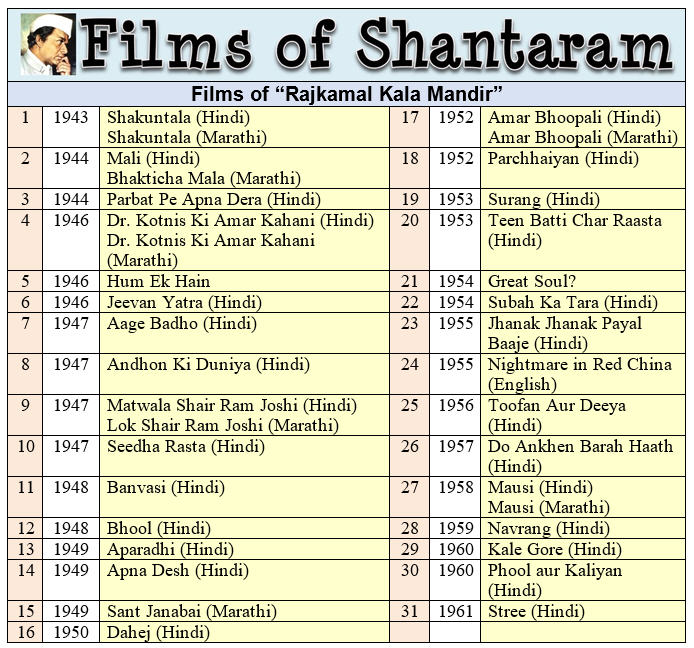 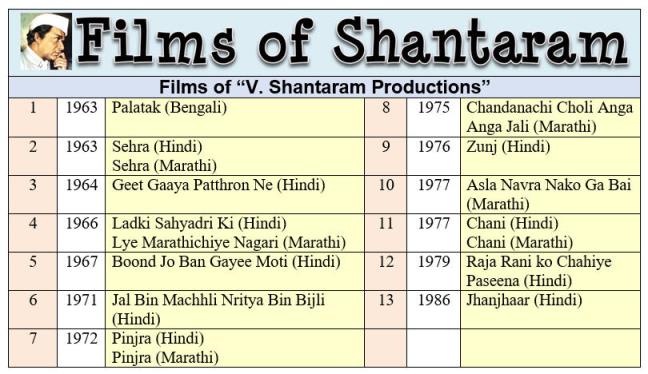
|
  |
Replies
| swarapriya |
 Mar 3 2019, 07:32 PM Mar 3 2019, 07:32 PM
Post
#2
|
|
Dedicated Member  Group: Angels Posts: 15469 Joined: 8-January 08 Member No.: 36307 |
Ayodhya Ka Raja (1932-Hindi) & Ayodhyecha Raja (1932-Marathi) - Prabhat's First Talkie
Silent movies are part of history now. World has seen talking movies take over. It has swept movie going public around the world in awe and amazement. Watching movies was never going to be the same again. Not to be left behind India saw the talkies phenomenon take over. For the first time people were able to see in the movie actors talking, singing, dancing, laughing, and crying. They could hear singing of the birds, roaring of the river rapids, splashing of ocean waves, whispering of the winds, and every listening experience you can imagine. Here we are. Shantaram, his partners, and their company Prabhat films was not far behind. The following story unfolds how it all started for them… This was the first talkie to come from Prabhat Film Company. The emblem of Prabhat was originally thought by Shantaram when he sat down near a temple and saw the sun rising. He explained this first to one of his partners, Fatehlal. He told him that a woman steps forward ushering the rising sun in the eastern sky. Fatehlal immediately drew the sketch from that description. See this sketch attached below. All partners agreed this to be the emblem for their company unanimously. This talkie was the first talkie directed by Shantaram. It was also the first Marathi talkie. It was considered to be a technical leap in movies because of the song and dialogue quality. The movie also boasted splendid sets like the ones never seen before, trick photography, and gripping realism with uncompromising principles of the king. The Marathi version of this film, “Ayodhyecha Raja,” in video format is available. However the Hindi version, “Ayodhya Ka Raja,” is not. Durga Khote who played Taramati in these films, was from an upper class elite Brahmin family and well educated (she had a B.A. degree). Her taking the role of Taramati is now recognized as the one that gave a social leap. Until that time it was considered a taboo for women of upper class to be part of the films. “Alam Ara” which was released in 1931 was the first talkie produced in India. But in 2003 fire at the National Archives of India the film was destroyed. By default “Ayodhyecha Raja” is now considered to be the first talkie (because it is available). Shantaram made this movie in Marathi as “Ayodhyecha Raja” and in Hindi as “Ayodhya Ka Raja” simultaneously. Its title in English “The King of Ayodhya”. For some curious reason Prabhat gave their movies an English title. It was the first Marathi talkie and the first bilingual talkie made in India. The decision to make the film in two languages proved to be crucial for Prabhat as well as the rest of the industry. It set a pattern for much of the filmmaking in the 1930s. Besides directing the film, Shantaram also edited the film. This was a mythological story taken from the epic Mahabharata, of king Harishchandra. It is interesting to note that the first silent feature length movie made by Dadasaheb Phalke (see his picture attached below) in 1913 was “Raja Harishchandra”. This first talkie Shantaram directed took the same story. Many people believe that this was a gesture by Shantaram paying a tribute to Phalke. In later years Shantaram became a close friend of Phalke. When Phalke’s fortunes turned bad and became very poor both physically and financially, Shantaram helped him by sending money every month. The movie was shot on elaborate plaster sets. They were designed by Fatehlal. There were some daring shots in the film. For example, in a burning forest, a tree falls on the ground missing the king. Granted the movie depended upon stage-driven frontal compositions, but underneath all this there was a genuine attempt to be realistic as well. This was evident in the scenes where the king’s family is impoverished and trying hard to earn a living. In Phalke’s movie Taramati was played by a man. He was not able to get any female to perform that role. Women feared appearing in the films because people looked down on them. That taboo was completely broken with the appearance of Durga Khote in this Shantaram’s film. Here is a word about Mrs. Khote. See her attached picture below. She came from an elite Brahmin family. As soon as she graduated from the college she got married. Her husband passed away when she was just 25 years old and she had two little kids to raise. She was an independent woman and did not want to take any help from her parents. She was ready to take any job. She was neither an actress nor a singer. Yet, through her sister’s acquaintance she got a small role in Mohan Bhavnani’s 1931 Hindi film “Farebi Jaal”. The English title of the movie was “Trapped”. The movie flopped and she felt embarrassed at the whole experience. Not many people saw “Trapped” but one of those who saw it was Shantaram. He decided to offer her the role of “Taramati” in his first talkie, “Ayodhyecha Raja”. She accepted the offer. The movie became a success in both Hindi and Marathi versions. Shantaram also cast her for his next film “Maya Machhindra” which again hit the bull’s eye with the audience. From there onwards there was no looking back for Mrs. Khote. Remember this was the first talkie by Prabhat Films. There were only few talking movies thus far that came out. Technicians who were experts and very proficient in silent movies have yet to get a handle with the sound. The system itself was still in primitive stages. That is why the audio quality of the soundtrack of the film is noisy and of inferior quality. The Marathi version of the film was a huge success. After all it was the first Marathi talkie. Hindi version did not fare well as the Marathi version except in Mumbai. Yet it was billed as a success. The movie’s success gave a firm footing for Prabhat. In the coming years they will have a huge impact on how the films are made and what people want to see in them. Details of songs from both versions follow starting in the next post… This post has been edited by swarapriya: Mar 3 2019, 07:59 PM Attached image(s) 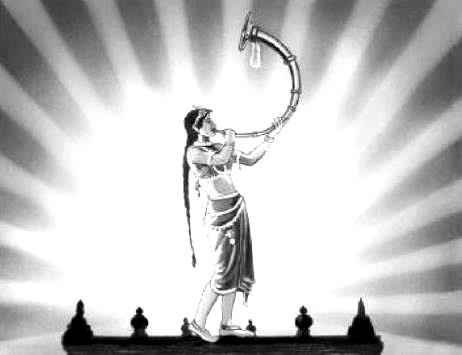  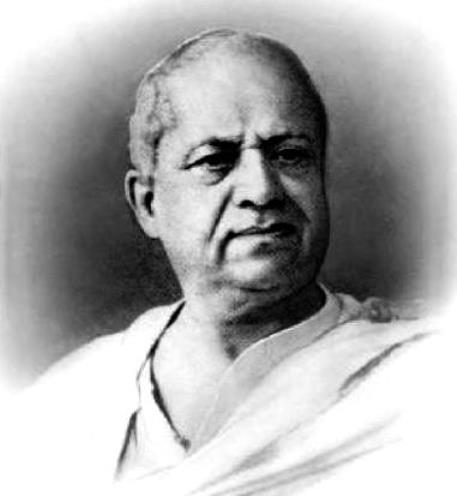 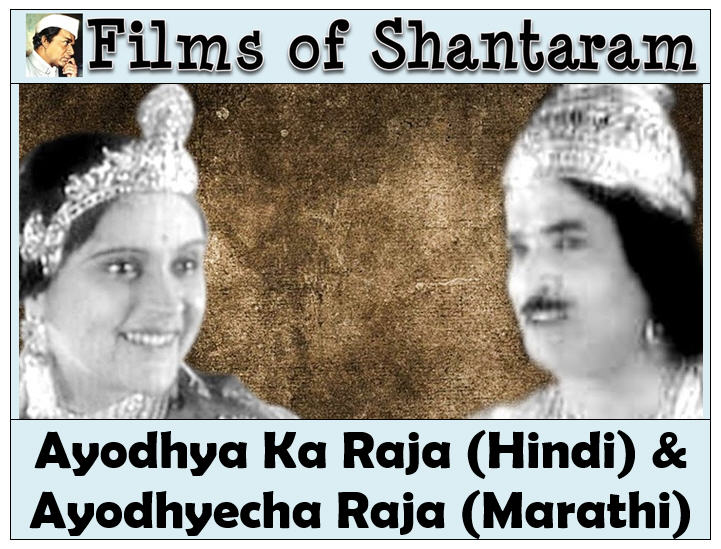
|
Posts in this topic
 swarapriya Visionary - V. Shantaram Jan 6 2019, 09:23 PM
swarapriya Visionary - V. Shantaram Jan 6 2019, 09:23 PM
 swarapriya Surekha Haran (1921) - A Silent Film
This silent ... Jan 6 2019, 09:28 PM
swarapriya Surekha Haran (1921) - A Silent Film
This silent ... Jan 6 2019, 09:28 PM
 Viraj Padhye Nice topic SP. Thanks. Jan 7 2019, 08:19 AM
Viraj Padhye Nice topic SP. Thanks. Jan 7 2019, 08:19 AM

 swarapriya
Nice topic SP. Thanks.
Thank you very much Vira... Jan 7 2019, 10:29 PM
swarapriya
Nice topic SP. Thanks.
Thank you very much Vira... Jan 7 2019, 10:29 PM

 Viraj Padhye
Nice topic SP. Thanks.
Thank you very much Vir... Jan 8 2019, 07:30 AM
Viraj Padhye
Nice topic SP. Thanks.
Thank you very much Vir... Jan 8 2019, 07:30 AM

 swarapriya
[quote name='swarapriya' post='753035' date='Jan ... Jan 8 2019, 08:58 PM
swarapriya
[quote name='swarapriya' post='753035' date='Jan ... Jan 8 2019, 08:58 PM
 swarapriya Damaji (1922) - A Silent Film
This silent Marathi... Jan 8 2019, 09:00 PM
swarapriya Damaji (1922) - A Silent Film
This silent Marathi... Jan 8 2019, 09:00 PM
 swarapriya Sinhagad (1923) - A Silent Film
This silent Marat... Jan 10 2019, 09:42 PM
swarapriya Sinhagad (1923) - A Silent Film
This silent Marat... Jan 10 2019, 09:42 PM
 swarapriya Sati Padmini (1924) - A Silent Film
This silent M... Jan 13 2019, 09:22 PM
swarapriya Sati Padmini (1924) - A Silent Film
This silent M... Jan 13 2019, 09:22 PM
 swarapriya Shri Krishna Avatar (1924) - A Silent Film
This s... Jan 15 2019, 09:56 PM
swarapriya Shri Krishna Avatar (1924) - A Silent Film
This s... Jan 15 2019, 09:56 PM
 swarapriya Maya Bazar (1925) - A Silent Film
This silent Mar... Jan 17 2019, 08:10 PM
swarapriya Maya Bazar (1925) - A Silent Film
This silent Mar... Jan 17 2019, 08:10 PM
 swarapriya Rana Hamir (1925) - A Silent Film
Baburao Painter... Jan 20 2019, 10:48 PM
swarapriya Rana Hamir (1925) - A Silent Film
Baburao Painter... Jan 20 2019, 10:48 PM
 swarapriya Savkari Pash (1925) - A Silent Classic
This silen... Jan 22 2019, 09:17 PM
swarapriya Savkari Pash (1925) - A Silent Classic
This silen... Jan 22 2019, 09:17 PM
 swarapriya Shahala Shah (1925) - A Silent Film
This was the ... Jan 24 2019, 07:45 PM
swarapriya Shahala Shah (1925) - A Silent Film
This was the ... Jan 24 2019, 07:45 PM

 soumik Thanks Swarapriya for starting this thread....
1.... Jan 26 2019, 11:50 PM
soumik Thanks Swarapriya for starting this thread....
1.... Jan 26 2019, 11:50 PM

 swarapriya
Thanks Swarapriya for starting this thread....
1... Jan 27 2019, 10:04 PM
swarapriya
Thanks Swarapriya for starting this thread....
1... Jan 27 2019, 10:04 PM

 soumik Dear Swarapriya....
You got me wrong. I was askin... Jan 28 2019, 09:24 PM
soumik Dear Swarapriya....
You got me wrong. I was askin... Jan 28 2019, 09:24 PM

 swarapriya
Dear Swarapriya....
You got me wrong. I was aski... Jan 29 2019, 08:16 PM
swarapriya
Dear Swarapriya....
You got me wrong. I was aski... Jan 29 2019, 08:16 PM
 swarapriya Bhakt Prahlad (1926) - A Silent Film
This silent ... Jan 27 2019, 10:07 PM
swarapriya Bhakt Prahlad (1926) - A Silent Film
This silent ... Jan 27 2019, 10:07 PM
 swarapriya Gaja Gauri (1926) - A Silent Film
This silent Mar... Jan 29 2019, 08:18 PM
swarapriya Gaja Gauri (1926) - A Silent Film
This silent Mar... Jan 29 2019, 08:18 PM
 swarapriya Muraliwala (1927) - A Silent Film
This silent Mar... Jan 31 2019, 09:44 PM
swarapriya Muraliwala (1927) - A Silent Film
This silent Mar... Jan 31 2019, 09:44 PM
 swarapriya Netaji Palkar (1927) - A Silent Movie
Netaji Palk... Feb 3 2019, 08:00 PM
swarapriya Netaji Palkar (1927) - A Silent Movie
Netaji Palk... Feb 3 2019, 08:00 PM
 swarapriya Karna (1928) - A Silent Film
This silent Marathi ... Feb 5 2019, 09:37 PM
swarapriya Karna (1928) - A Silent Film
This silent Marathi ... Feb 5 2019, 09:37 PM
 swarapriya Nisha Sundary (1928) - A Silent Film
This silent ... Feb 7 2019, 06:27 PM
swarapriya Nisha Sundary (1928) - A Silent Film
This silent ... Feb 7 2019, 06:27 PM
 swarapriya Baji Prabhu Deshpande (1929) - A Silent Film
This... Feb 10 2019, 10:20 PM
swarapriya Baji Prabhu Deshpande (1929) - A Silent Film
This... Feb 10 2019, 10:20 PM
 swarapriya Gopal Krishna (1929) - A Silent Film
Shantaram al... Feb 12 2019, 10:33 PM
swarapriya Gopal Krishna (1929) - A Silent Film
Shantaram al... Feb 12 2019, 10:33 PM
 swarapriya Khooni Khanjar (1930) - A Silent Film
This silent... Feb 14 2019, 10:18 PM
swarapriya Khooni Khanjar (1930) - A Silent Film
This silent... Feb 14 2019, 10:18 PM
 swarapriya Rani Saheba (1930) - A Silent Film
This silent Ma... Feb 17 2019, 10:55 PM
swarapriya Rani Saheba (1930) - A Silent Film
This silent Ma... Feb 17 2019, 10:55 PM
 swarapriya Udaykal (1930) - A Silent Film
This silent Marath... Feb 19 2019, 07:38 PM
swarapriya Udaykal (1930) - A Silent Film
This silent Marath... Feb 19 2019, 07:38 PM
 swarapriya Chandrasena (1931) - A Silent Film
This was a sil... Feb 21 2019, 09:31 PM
swarapriya Chandrasena (1931) - A Silent Film
This was a sil... Feb 21 2019, 09:31 PM
 swarapriya Zulum (1931) - A Silent Film
This was the last si... Feb 24 2019, 09:30 PM
swarapriya Zulum (1931) - A Silent Film
This was the last si... Feb 24 2019, 09:30 PM
 swarapriya Ayodhya Ka Raja (1932) - Hindi
Neither the movie ... Mar 3 2019, 07:34 PM
swarapriya Ayodhya Ka Raja (1932) - Hindi
Neither the movie ... Mar 3 2019, 07:34 PM
 swarapriya Ayodhyecha Raja (1932) - Marathi
I am uploading a... Mar 3 2019, 07:45 PM
swarapriya Ayodhyecha Raja (1932) - Marathi
I am uploading a... Mar 3 2019, 07:45 PM
 swarapriya Concluding Songs from "Ayodhyecha Raja (1932)... Mar 3 2019, 07:49 PM
swarapriya Concluding Songs from "Ayodhyecha Raja (1932)... Mar 3 2019, 07:49 PM
 swarapriya Jalti Nishani (1932 - Hindi) & Agnikankan (193... Mar 10 2019, 06:12 PM
swarapriya Jalti Nishani (1932 - Hindi) & Agnikankan (193... Mar 10 2019, 06:12 PM
 swarapriya Jalti Nishani (1932 - Hindi)
Neither the movie ve... Mar 10 2019, 06:15 PM
swarapriya Jalti Nishani (1932 - Hindi)
Neither the movie ve... Mar 10 2019, 06:15 PM
 swarapriya Agnikankan (1932 - Marathi)
I am uploading all so... Mar 10 2019, 06:20 PM
swarapriya Agnikankan (1932 - Marathi)
I am uploading all so... Mar 10 2019, 06:20 PM
 swarapriya Concluding Songs from "Agnikankan (1932 - Mar... Mar 10 2019, 06:25 PM
swarapriya Concluding Songs from "Agnikankan (1932 - Mar... Mar 10 2019, 06:25 PM
 Nandu I had seen a few films on Door Darshan earlier. Gr... Mar 11 2019, 10:00 PM
Nandu I had seen a few films on Door Darshan earlier. Gr... Mar 11 2019, 10:00 PM

 swarapriya
I had seen a few films on Door Darshan earlier. G... Mar 13 2019, 06:15 PM
swarapriya
I had seen a few films on Door Darshan earlier. G... Mar 13 2019, 06:15 PM
 swarapriya Maya Machhindra (1932 - Hindi & Marathi)
This... Mar 17 2019, 06:30 PM
swarapriya Maya Machhindra (1932 - Hindi & Marathi)
This... Mar 17 2019, 06:30 PM
 swarapriya Maya Machhindra (1932 - Hindi)
The Hindi version ... Mar 17 2019, 06:37 PM
swarapriya Maya Machhindra (1932 - Hindi)
The Hindi version ... Mar 17 2019, 06:37 PM
 swarapriya Maya Machhindra (1932 - Marathi)
I am uploading a... Mar 17 2019, 06:43 PM
swarapriya Maya Machhindra (1932 - Marathi)
I am uploading a... Mar 17 2019, 06:43 PM
 swarapriya Continuing Songs from "Maya Machhindra (1932 ... Mar 17 2019, 06:48 PM
swarapriya Continuing Songs from "Maya Machhindra (1932 ... Mar 17 2019, 06:48 PM
 swarapriya Concluding Songs from "Maya Machhindra (1932 ... Mar 17 2019, 06:53 PM
swarapriya Concluding Songs from "Maya Machhindra (1932 ... Mar 17 2019, 06:53 PM
 swarapriya Kavyasrushti (1933) - Marathi
This was a short Ma... Mar 24 2019, 07:37 PM
swarapriya Kavyasrushti (1933) - Marathi
This was a short Ma... Mar 24 2019, 07:37 PM
 swarapriya Sairandhri (1933 - Hindi & Marathi)
This film... Mar 31 2019, 07:10 PM
swarapriya Sairandhri (1933 - Hindi & Marathi)
This film... Mar 31 2019, 07:10 PM
 swarapriya Sairandhri (1933 - Hindi)
Neither video nor songs... Mar 31 2019, 07:16 PM
swarapriya Sairandhri (1933 - Hindi)
Neither video nor songs... Mar 31 2019, 07:16 PM
 swarapriya Sairandhri (1933 - Marathi)
I have no information... Mar 31 2019, 07:18 PM
swarapriya Sairandhri (1933 - Marathi)
I have no information... Mar 31 2019, 07:18 PM
 swarapriya Sinhgad (1933 - Marathi)
This film was edited and... Apr 7 2019, 07:57 PM
swarapriya Sinhgad (1933 - Marathi)
This film was edited and... Apr 7 2019, 07:57 PM
 swarapriya Concluding Songs from "Sinhgad (1933 - Marath... Apr 7 2019, 08:01 PM
swarapriya Concluding Songs from "Sinhgad (1933 - Marath... Apr 7 2019, 08:01 PM
 swarapriya Amrit Mandhan (1934 - Hindi & Marathi)
This f... Apr 14 2019, 06:10 PM
swarapriya Amrit Mandhan (1934 - Hindi & Marathi)
This f... Apr 14 2019, 06:10 PM
 swarapriya Amrit Manthan (1934 - Hindi)
I am uploading all s... Apr 14 2019, 06:17 PM
swarapriya Amrit Manthan (1934 - Hindi)
I am uploading all s... Apr 14 2019, 06:17 PM
 swarapriya Continuing Songs from "Amrit Manthan (1934 - ... Apr 14 2019, 06:20 PM
swarapriya Continuing Songs from "Amrit Manthan (1934 - ... Apr 14 2019, 06:20 PM
 swarapriya Concluding Songs from "Amrit Manthan (1934 - ... Apr 14 2019, 06:24 PM
swarapriya Concluding Songs from "Amrit Manthan (1934 - ... Apr 14 2019, 06:24 PM
 swarapriya Amrit Manthan (1934 - Marathi)
This film and its ... Apr 14 2019, 06:28 PM
swarapriya Amrit Manthan (1934 - Marathi)
This film and its ... Apr 14 2019, 06:28 PM
 swarapriya Continuing Songs from "Amrit Manthan (1934 - ... Apr 14 2019, 06:32 PM
swarapriya Continuing Songs from "Amrit Manthan (1934 - ... Apr 14 2019, 06:32 PM
 swarapriya Concluding Songs from "Amrit Manthan (1934 - ... Apr 14 2019, 06:35 PM
swarapriya Concluding Songs from "Amrit Manthan (1934 - ... Apr 14 2019, 06:35 PM
 swarapriya Seetha Kalyanam (1934 - Tamil)
This was the only ... Apr 21 2019, 08:03 PM
swarapriya Seetha Kalyanam (1934 - Tamil)
This was the only ... Apr 21 2019, 08:03 PM
 swarapriya Chandrasena (1935 - Hindi & Marathi)
This fil... Apr 28 2019, 06:14 PM
swarapriya Chandrasena (1935 - Hindi & Marathi)
This fil... Apr 28 2019, 06:14 PM
 swarapriya Chandrasena (1935 - Hindi)
Unfortunately, I do no... Apr 28 2019, 06:18 PM
swarapriya Chandrasena (1935 - Hindi)
Unfortunately, I do no... Apr 28 2019, 06:18 PM
 swarapriya Chandrasena (1935 - Marathi)
I am uploading songs... Apr 28 2019, 06:23 PM
swarapriya Chandrasena (1935 - Marathi)
I am uploading songs... Apr 28 2019, 06:23 PM
 swarapriya Concluding Songs from "Chandrasena (1935 - Ma... Apr 28 2019, 06:27 PM
swarapriya Concluding Songs from "Chandrasena (1935 - Ma... Apr 28 2019, 06:27 PM  |
1 User(s) are reading this topic (1 Guests and 0 Anonymous Users)
0 Members:

|
Lo-Fi Version | Disclaimer | HF Guidelines |  |
Time is now: 19th June 2025 - 06:17 PM |
Invision Power Board
v2.1.7 © 2025 IPS, Inc.
Licensed to: Hamaraforums.com








